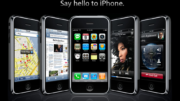Folks, this is a question I’ve been asked multiple times. I think it comes from people who have paid to have their cell phone signal boosters installed by a professional. There’s nothing wrong with that, but clearly some of those installers aren’t leaving their customers with enough information. Oh well! That’s why blogs like this are here.
A little about cell phone signal boosters
You probably know all about cell boosters since you found this article. Here’s something you might not know: the signal from the two antennas must never “cross over.” In other words, the indoor antenna must never receive the transmitted signal from the outdoor antenna. The opposite is true, too: the outdoor antenna should never be able to detect a signal from the indoor antenna.
If the signals from the antennas cross over, it sets up a feedback loop. You’re familiar with feedback. Anyone who has ever been in a large room with a microphone is. Audio feedback comes when a microphone “hears” the output from the speaker it’s attached to. It becomes painful pretty quickly. Cell phone signal booster feedback is pretty much the same. The difference is, instead of making one ballroom’s worth of people unhappy, it could take down an entire cell tower. Left unchecked, the whole cell system could go down. That would be… bad.
So, cell boosters use complex computer technology to stop that from happening. The booster checks for feedback multiple times a second. If there’s even a start to a feedback loop, if either antenna can so much as detect a signal from the other, power to the whole system is reduced. This means the cell system is safe, but it also means you’re not getting all the power you’ve paid for.
Moving the indoor antenna
Most folks put the indoor antenna for their cell booster where they need signal to be strongest. The best case scenario is putting it in the center of your house, office, or vehicle. That way it gets maximum power to the largest possible area. But sometimes patterns change. Sometimes there are dead spots that come to light after the install.
One common problem when installing cell boosters for home or office is a dead spot in the bathroom. Gross or not, that’s where a lot of people use their phones. It’s just a fact. But, bathrooms are full of pipes and mirrors and all sorts of things that block cell signals. You might end up moving the indoor antenna or even adding a second one to make up for all that.
It’s perfectly all right to move the indoor antenna. In most cases you can use store-bought RG6 cable to do it. If the connector on your booster’s antennas looks like the one used for cable TV, that’s all it’s going to take. However, take a look at the booster itself to make sure that everything still works after you move the antennas. Look for flashing lights or for red lights. Those are a sign that the booster is reducing power or shutting down. If you see that, unplug the booster and move the indoor antenna again. Then plug the booster back in and see if you get that solid green light.
The cellular accessories you really need
Solid Signal is your home for the cell boosters and accessories you really need. You’ll find all the top brands and all the approved accessories. Shop our web site now! But hey, I know. You can shop anywhere online. But, how many of those web sites are full of experts who actually pick up the phone? You don’t need to wait three or four days for someone to get back to you. Just call the folks at Solid Signal! We’re here for you during East Coast business hours. Call us at 888-233-7563. If it’s after hours, fill out the form below. Our team is great about responding within one business day.





